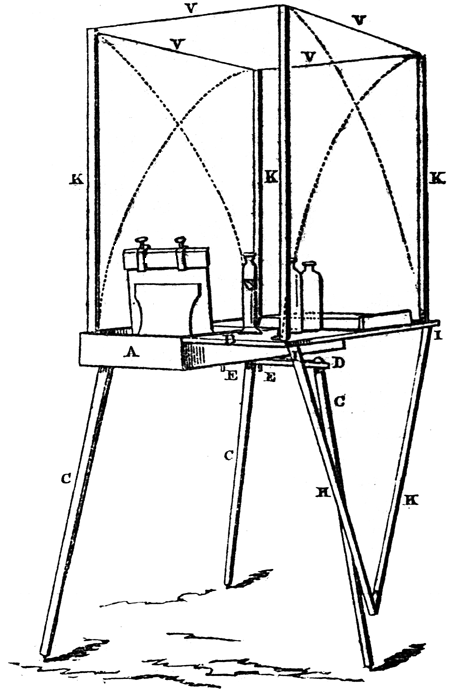
THE PHOTOGRAPHIC NEWS. February 18, 1859, p. 284
Correspondence
Sir,--Enclosed, I have ventured to send you two photographs of a dark tent which I have constructed, and which I think has some advantages over those in general use: to us of the camera who prefer seeing what we are about, a simple and portable tent, capable of manipulating large as well as small plates with perfect facility, would be acceptable in more points than one. The cost would not exceed one fourth of what is usually charged for one of the same capabilities

Fig. 1
The box A, which forms the table, is made of light deal wood, ½ an inch thick (or less), dove-tailed together at the angles, and is 3 feet long, 13 inches wide, and 3½ inches deep, inside measurement. The lid B should be "clamped" with cross pieces grooved into the ends to prevent warping, and be hinged so as to open level with the top of the box. The. legs C C C are of beech, tapered towards the bottom, and having a screw turned on the top (which any turner can do); two of them screw into blocks (also of beech) about 1 inch thick, glued inside in the front corners of the box, the third into the projecting piece D, at the back, which is fastened at the edge and middle of the box with wooden thumb-screws E E, either screw being removable, so as to allow it to perform a quarter of a circle, and lie along the box when travelling. The back leg is provided with a small staple at F, to admit the point of a wire driven into the bottom of one of the pieces H H, which fold together at me-with a hinge (see Fig. 2), and when open support the lid (see Fig. 2).

Fig. 2
Four pieces of deal K K K (about 1 inch wide and ½ an inch thick) are hinged to the upper corners of the box, as shown in the engraving, so as to pass each other in the direction of the dotted lines on disengaging the wires L L at the end only, the other end being looped over small wire staples in the upper part of the uprights, so that they fail down and fold, one with each of the uprights. It now remains to fit the covering, which consists of one thickness of black glazed calico, and one thickness of yellow calico (the former being outside, of course); it is made to fit exactly over the top, back, and ends of the upper framework. The front piece is shaped like the section of a truncated cone, the width of the top being the length of the box, and the bottom descending about 18 inches below the box, and extending the same beyond each side; this piece is sewn into the front amid forms a sort of hood. The open space below the box inside the hood is supplied with a piece of the stuff used, nailed along the inside of the box just below the edge. The whole is now to be nailed round the other three sides of the box and lid on the inside with small tacks; and on folding down the uprights, the tent can be neatly doubled up to allow the box to be closed, the legs can now be unscrewed and laid inside, and the lid fastened by means of a strap or other contrivance. I forgot to mention, that the window M is made by cutting out a square of the black stuff, and inserting two thicknesses more of the yellow linen.

Fig. 3
JOHN C. TWYMAN.